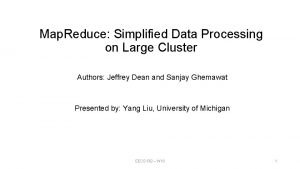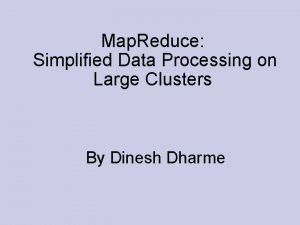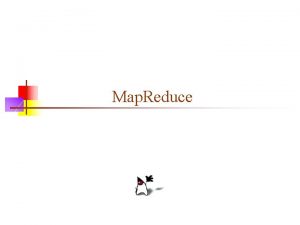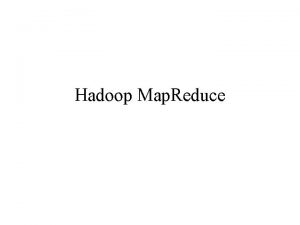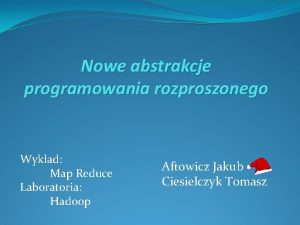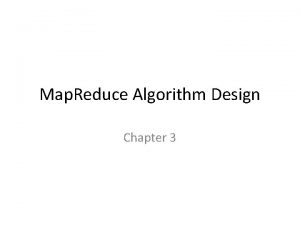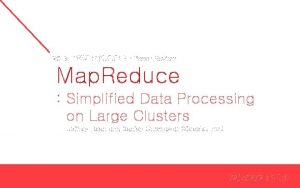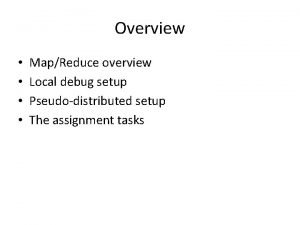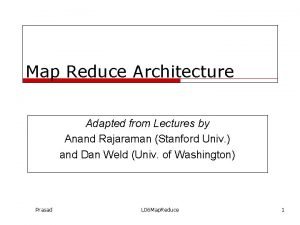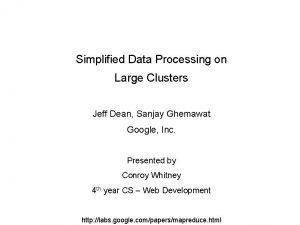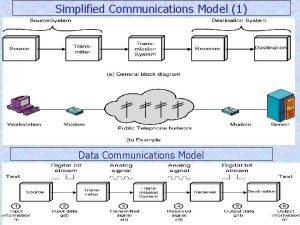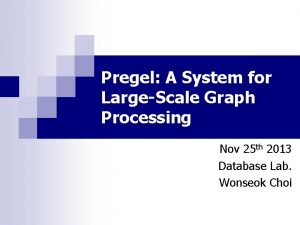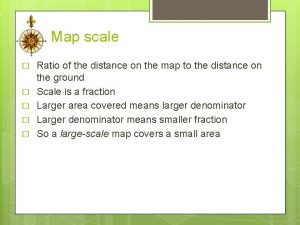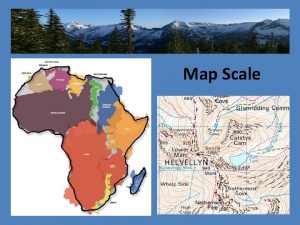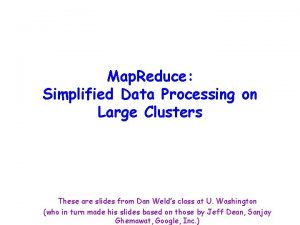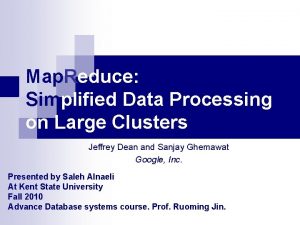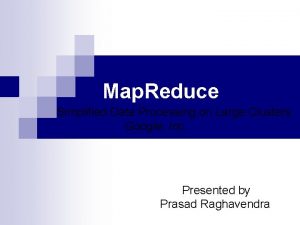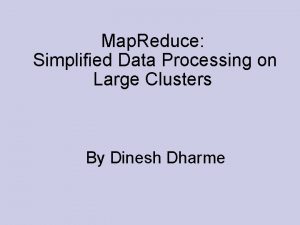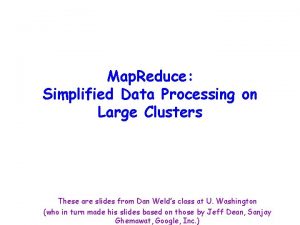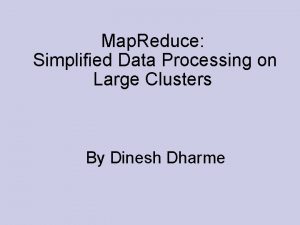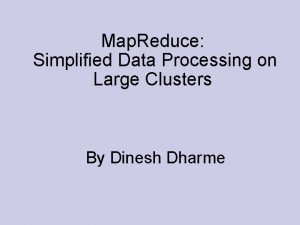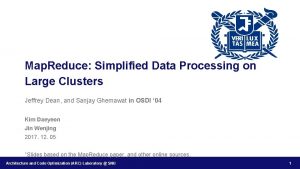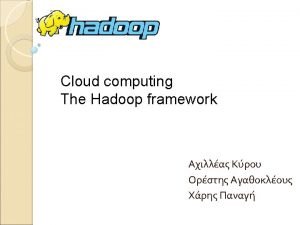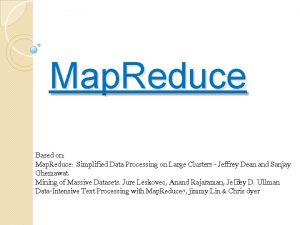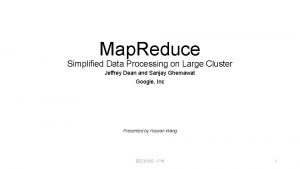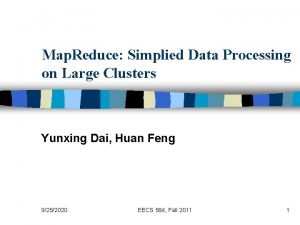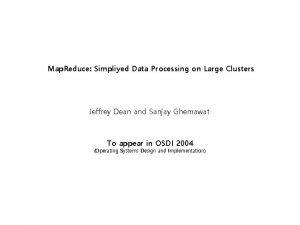Map Reduce Simplified Data Processing on Large Clusters







































- Slides: 39

Map. Reduce: Simplified Data Processing on Large Clusters Jeffrey Dean & Sanjay Ghemawat Presented by: Hemanth Makkapati (makka@vt. edu) Appeared in: OSDI '04: Sixth Symposium on Operating System Design and Implementation, San Francisco, CA, December, 2004.

Mom told Sam An apple a day keeps a doctor away!

One day Sam thought of “drinking” the apple So, he used a the and a make juice. to cut to

Next Day Sam applied his invention to all the fruits he could find in the fruit basket Simple!!!

18 Years Later Sam got his first job with juice making giants, Joogle, for his talent in making juice But! • Now, it’s not just one basket but a whole container of fruits • Fruit s Also, he has to make juice of different fruits separately • And, Sam has just ONE and Simple? ? ? Is this representative of computations that process large-scale data?

Why? • The operations themselves are conceptually simple – Making juice – Indexing – Recommendations etc • But, the data to process is HUGE!!! – Google processes over 20 PB of data every day • Sequential execution just won’t scale up

Why? • Parallel execution achieves greater efficiency • But, parallel programming is hard – Parallelization • Race Conditions • Debugging – Fault Tolerance – Data Distribution – Load Balancing

Map. Reduce • “Map. Reduce is a programming model and an associated implementation for processing and generating large data sets” • Programming model – Abstractions to express simple computations • Library – Takes care of the gory stuff: Parallelization, Fault Tolerance, Data Distribution and Load Balancing

Programming Model • To generate a set of output key-value pairs from a set of input key-value pairs – { < ki, vi >} { < ko, vo >} • Expressed using two abstractions: – Map task • <ki, vi> { < kint, vint > } – Reduce task • < kint, {vint} > < ko, vo > • Library – aggregates all the all intermediate values associated with the same intermediate key – passes the intermediate key-value pairs to reduce function

Inspiration • ‘map’ & ‘reduce/fold’ of functional programming languages • (map f list [list 2 list 3 …]) – (map square (1 2 3 4)) (1 4 9 16) • (reduce f list […]) – (reduce + (1 4 9 16)) 30 • (reduce + (map square (map – l 1 l 2))))

Example Map Reduce

Example: Word Count map(String input_key, String input_value): // input_key: document name // input_value: document contents for each word w in input_value: Emit. Intermediate(w, "1"); <“Sam”, “ 1”>, <“Apple”, “ 1”>, <“Sam”, “ 1”>, <“Mom”, “ 1”>, reduce(String output_key, Iterator intermediate_values): // output_key: a word <“Sam” , [“ 1”, ” 1”]>, <“Apple” , [“ 1”]>, // output_values: a list of counts <“Mom” , [“ 1”, “ 1”]> int result = 0; for each v in intermediate_values: result += Parse. Int(v); “ 3” Emit(As. String(result)); “ 1” “ 2”

Implementation • Large cluster of commodity PCs – Connected together with switched Ethernet – X 86 dual-processor, 2 -4 GB memory each – Linux OS – Storage by GFS on IDE disks • Scheduling system – Users submit jobs – Tasks are scheduled to available machines on cluster

Google File System (GFS) • File is divided into several chunks of predetermined size – Typically, 16 -64 MB • Replicates each chunk by a predetermined factor – Usually, three replicas • Replication to achieve fault-tolerance – Availability – Reliability

GFS Architecture

Execution • User specifies – M: no. of map tasks – R: no. of reduce tasks • Map Phase – input is partitioned into M splits – map tasks are distributed across multiple machines • Reduce Phase – reduce tasks are distributed across multiple machines – intermediate keys are partitioned (using partitioning function) to be processed by desired reduce task

Execution Flow

Sam & Map. Reduce Sam implemented a parallel version of his innovation Fruit s

Master Data Structures • For each task – State { idle, in-progress, completed } – Identity of the worker machine • For each completed map task – Size and location of intermediate data

Fault Tolerance • Worker failure – handled via re-execution – Identified by no response to heartbeat messages – In-progress and Completed map tasks are rescheduled – Workers executing reduce tasks are notified of rescheduling – Completed reduce tasks are not re-scheduled • Master failure – Rare – Can be recovered from checkpoints – All tasks abort

Disk Locality • Leveraging GFS • Map tasks are scheduled close to data – on nodes that have input data – if not, on nodes that are nearer to input data • Ex. Same network switch • Conserves network bandwidth

Task Granularity • No. of map tasks > no. of worker nodes – Better load balancing – Better recovery • But, increases load on Master – More scheduling decisions – More states to be saved • M could be chosen w. r. t to block size of the file system – to effectively leverage locality • R is usually specified by users – Each reduce task produces one output file

Stragglers • Slow workers delay completion time – Bad disks with soft errors – Other tasks eating up resources – Strange reasons like processor cache being disabled • Start back-up tasks as the job nears completion – First task to complete is considered

Refinement: Partitioning Function • Identifies the desired reduce task – Given the intermediate key and R • Default partitioning function – hash(key) mod R • Important to choose well-balanced partitioning functions – If not, reduce tasks may delay completion time

Refinement: Combiner Function • Mini-reduce phase before the intermediate data is sent to reduce • Significant repetition of intermediate keys possible – Merge values of intermediate keys before sending to reduce tasks • Similar to reduce function • Saves network bandwidth

Refinement: Skipping Bad Records • Map/Reduce tasks may fail on certain records due to bugs – Ideally, debug and fix – Not possible if third-party code is buggy • When worker dies, Master is notified of the record • If more than one worker dies on the same record – Master re-schedules the task and asks to skip the record

Refinements: others • Ordering guarantees – sorted output file • Temporary files • Local sequential execution – to debug and test • Status Information – input, intermediate & output bytes processed so far – error & failure reports • Counters – to keep track of specific events

Performance • Evaluated on two programs running on a large cluster & processing 1 TB data – grep & sort • Cluster Configuration – 1800 machines • • 2 GHz Intel Xeon processors 4 GB memory two 160 GB IDE disks gigabit Ethernet link – Hosted in the same facility

Grep • • • Scans for a three character pattern M = 15000 @ 64 MB per split R=1 Entire computation takes 150 s Startup overhead apprx. 60 s – Propagation of programs to worker machines – GFS operations – Information of locality optimizations

Sort • • • Models Tera. Sort benchmark M = 15000 @ 64 MB per split R = 4000 Workers = 1700 Evaluated on three executions – with backup tasks – without backup tasks – with machine failures

Sort Normal execution Without backup tasks With machine failures

Experience: Google Indexing System • Complete re-write using Map. Reduce • Modeled as a sequence of multiple Map. Reduce operations • Much simpler code – fewer Lo. C – shorter code changes – easier to improve performance

Conclusion • Easy to use scalable programming model for large-scale data processing on clusters – Allows users to focus on computations • Hides issues of – parallelization, fault tolerance, data partitioning & load balancing • Achieves efficiency through disk-locality • Achieves fault-tolerance through replication

New Trend: Disk-locality Irrelevant • Assumes disk bandwidth exceeds network bandwidth • Network speeds fast improving • Disk speeds have stagnated • Next step: attain memory-locality

Hadoop • An open-source framework for dataintensive distributed applications • Inspired from Google’s Map. Reduce & GFS • Implemented in Java • Name after the toy elephant of creator’s son

Hadoop History • Nutch, an effort to develop open-souce search engine • Soon, encountered scalability issues to store and process large data sets • Google published Map. Reduce and GFS • Attempted re-creation for Nutch • Yahoo! got interested and contributed

Hadoop Ecosystem • Hadoop Map. Reduce – inspired by Google’s Map. Reduce • Hadoop Distributed File System(HDFS) – inspired by Google File System • HBase – Hadoop Database – inspired by Google Big. Table • Cassandra – Distributed Key-Value Store – Inspired by Amazon Dynamo & Google Big. Table

References • Google File System – http: //labs. google. com/papers/gfs. html • Google Big. Table – http: //labs. google. com/papers/bigtable. html • Apache Hadoop – http: //hadoop. apache. org/ • Juice Example – http: //esaliya. blogspot. com/2010/03/mapred uce-explained-simply-as-story-of. html

Thank you
 Sanjay ghemawat
Sanjay ghemawat Mapreduce simplified data processing on large clusters
Mapreduce simplified data processing on large clusters Mapreduce simplified data processing on large clusters
Mapreduce simplified data processing on large clusters Guide to computer forensics and investigations
Guide to computer forensics and investigations Mapreduce شرح
Mapreduce شرح Map reduce types
Map reduce types Map reduce word count
Map reduce word count Google map reduce
Google map reduce Java map reduce
Java map reduce Map reduce algorithm
Map reduce algorithm Map reduce algorithm
Map reduce algorithm Map reduce paper
Map reduce paper Map-reduce
Map-reduce Map reduce program
Map reduce program Map-reduce
Map-reduce Sherpamap
Sherpamap Java map reduce
Java map reduce Lisp map reduce
Lisp map reduce Google map reduce
Google map reduce Simplified communications
Simplified communications William stallings data and computer communications
William stallings data and computer communications Pregel: a system for large-scale graph processing
Pregel: a system for large-scale graph processing Bottom up and top down processing
Bottom up and top down processing Bottom up processing vs top down processing
Bottom up processing vs top down processing Bottom up and top down processing
Bottom up and top down processing Point processing and neighbourhood processing
Point processing and neighbourhood processing What is primary processing
What is primary processing Image enhancement by point processing
Image enhancement by point processing Histogram processing in digital image processing
Histogram processing in digital image processing Parallel processing vs concurrent processing
Parallel processing vs concurrent processing Laplacian filter
Laplacian filter پردازش تصویر
پردازش تصویر Morphological processing in digital image processing
Morphological processing in digital image processing What is top down processing
What is top down processing What is interactive processing
What is interactive processing Linear geography
Linear geography Scale on map definition
Scale on map definition Large scale vs small scale map
Large scale vs small scale map Large scale chart definition
Large scale chart definition Large scale vs small scale map
Large scale vs small scale map
